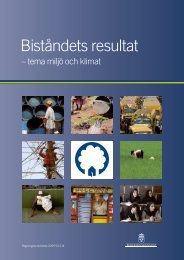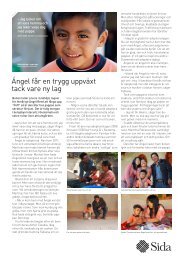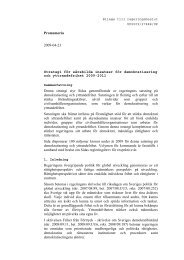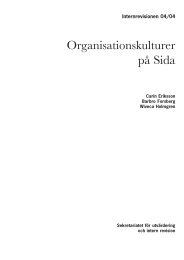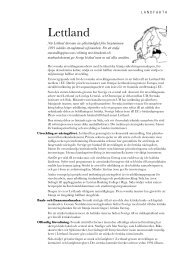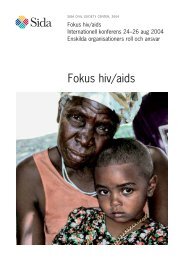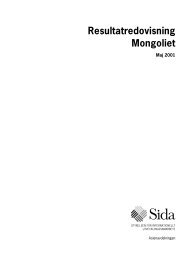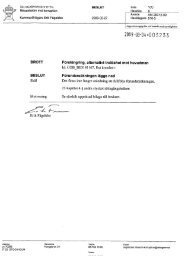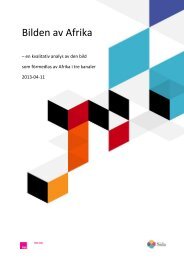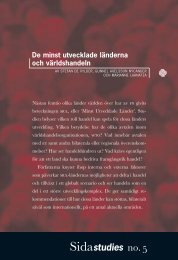Mid-Term Review of the AGIR Programme - Sida
Mid-Term Review of the AGIR Programme - Sida
Mid-Term Review of the AGIR Programme - Sida
You also want an ePaper? Increase the reach of your titles
YUMPU automatically turns print PDFs into web optimized ePapers that Google loves.
2 F I N D I N G S<br />
<strong>of</strong> Sou<strong>the</strong>rn Africa) respectively due to irregularities, some <strong>of</strong> which were detected in<br />
connection with annual audits <strong>of</strong> <strong>AGIR</strong> partners.<br />
While <strong>the</strong> three cases show that <strong>AGIR</strong> programme-oriented audits work, <strong>the</strong> question<br />
is: to what extent could such cases have been prevented? The initial partner assessment<br />
shows weaknesses in <strong>the</strong> elected structures <strong>of</strong> <strong>the</strong> organisation, i.e. <strong>the</strong> fiscal<br />
council did not meet regularly, <strong>the</strong> financial report had not been approved by <strong>the</strong> general<br />
assembly and <strong>the</strong> audit report had not been submitted to general assembly. Likewise,<br />
in <strong>the</strong> case <strong>of</strong> MEPT that was evaluated by Diakonia, it was clear from <strong>the</strong> evaluation<br />
that MEPT needed to streng<strong>the</strong>n different financial management areas. But this<br />
is not unusual. According to <strong>the</strong> intermediaries, it is difficult to completely avoid new<br />
cases, but <strong>the</strong>y have become more alert in <strong>the</strong> in-depth partner assessment. As discussed<br />
in <strong>the</strong> evaluation methodology section, programmes such as <strong>AGIR</strong> can influence,<br />
but can not control, <strong>the</strong> organisations with which <strong>the</strong>y work. This becomes even<br />
more relevant when operating under principles <strong>of</strong> good-donorship. Having an increased<br />
awareness and viable systems in place to identify and mitigate risk are <strong>the</strong>refore<br />
critical for intermediaries.<br />
The centrality <strong>of</strong> <strong>the</strong> principles <strong>of</strong> good donorship and <strong>the</strong> mechanism <strong>of</strong> core-funding<br />
to <strong>the</strong> <strong>AGIR</strong> programme are perhaps most important for new prospective donors to<br />
understand. As will be demonstrated in <strong>the</strong> following sections <strong>of</strong> this review, <strong>the</strong>se<br />
two elements play a central role in <strong>the</strong> character <strong>of</strong> <strong>the</strong> <strong>AGIR</strong> programme and are, in<br />
different ways, central to <strong>the</strong> outcomes (results) related to <strong>the</strong> work <strong>the</strong> intermediaries<br />
are undertaking with partner CSOs. Involvement in <strong>the</strong> programme would also mean<br />
endorsing this fundamental, and effective, principle <strong>of</strong> operation.<br />
2.3.2 Viewing <strong>AGIR</strong> as a Single <strong>Programme</strong> - Adequacy <strong>of</strong> Operational Structures and<br />
Mechanisms<br />
A central question stated in <strong>the</strong> ToR for this mid-term review focused on <strong>the</strong> need to<br />
understand how <strong>the</strong> programme is functioning as “one programme” with subprogrammes<br />
(not as separate distinct sub-programmes only). While <strong>the</strong> intermediaries<br />
were not to be one <strong>of</strong> <strong>the</strong> subjects <strong>of</strong> this mid-term evaluative review, identifying and<br />
assessing <strong>the</strong> functioning <strong>of</strong> <strong>the</strong> intermediaries and <strong>the</strong> capacity streng<strong>the</strong>ning work<br />
<strong>the</strong>y undertake with <strong>the</strong>ir CSO partners, have to be considered critical to its overall<br />
success.<br />
A specific element <strong>of</strong> <strong>the</strong> management framework that was noted by <strong>the</strong> external<br />
voices was <strong>the</strong> perceived role <strong>of</strong> <strong>the</strong> intermediaries within <strong>the</strong> programme and its<br />
higher level <strong>of</strong> visibility, vis-a-vis <strong>the</strong> overall ‘programme’ or <strong>the</strong> CSO ‘partner’ organisations.<br />
Among many <strong>of</strong> <strong>the</strong> CSO partners, <strong>the</strong> face <strong>of</strong> <strong>AGIR</strong> is that <strong>of</strong> <strong>the</strong> intermediary<br />
as donor. This impression is widespread among CSOs in <strong>the</strong> provinces visited<br />
by <strong>the</strong> team. The relation between intermediary and partner was mentioned in <strong>the</strong><br />
2011 semi-annual report as a challenge to <strong>the</strong> consolidation <strong>of</strong> <strong>AGIR</strong> as a programme.<br />
Some interviewees even go fur<strong>the</strong>r, expressing <strong>the</strong>ir impressions that this relation<br />
might lead to a kind <strong>of</strong> a clientlistic relation, which can hinder sustainability.<br />
36




